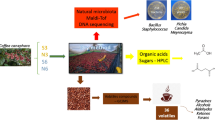Abstract
A total of 272 strains of filamentous fungi were isolated from soil, leaves of coffee plants and coffee cherries collected in coffee-growing areas of Mexico on three semi-synthetic culture media containing coffee extract, coffee extract with sucrose and coffee pulp extract. The isolated strains were purified by conventional techniques and identified by microscopic examination. Strains were selected on the basis of their caffeine-degrading ability in well-defined liquid medium containing caffeine. Most of the isolated microorganisms belong to Aspergillus, Penicillium, Trichoderma, Fusarium, and Humicola genera. Five strains belonging to Aspergillus species and two strains belonging to Penicillium species had the ability to degrade almost 100% of the caffeine in liquid medium. A comparative study on the evaluation of natural microflora present in coffee pulp and coffee husk revealed the presence of a wide variety of microorganisms. The percentage distribution of fungi, bacteria and yeast was almost similar in all the samples, except in coffee husk where the fungal population was slightly higher than in the other two samples. The yeast population was predominant when the coffee pulp was lyophilized immediately after pulping. However, there was a wide diversity in the microbial population with respect to selective media containing functional nutritional groups like cellulose, starch and pectin.
Similar content being viewed by others
References
Adams MR, Dougan J (1981) Biological management of coffee processing. Trop Sci 123:178–196
Ainsworth GC (1973) Introduction and keys to the higher taxa. In: The fungi. An advanced treatise vol 4a. A taxonomic review keys. Academic Press, New York
Aquiahuatl MA (1992) Detoxificación de la pulpa decafé: Morfologia, Fisiologia y Bioquimica de hongos filamentosos que degradan la cafeina. Tesis Maestria en Ciencias, Universidad National Autonoma de Mexico (UNAM), Mexico
Arx von JA The genera of fungi sporulating in pure culture. Cramer J, Vaduz 2nd Ed.
Barnet HL, Hunter BB (1972) Illustrated genera of imperfect fungi, 3rd edn. Burgels, Minneapolis
Bressani R (1979) Antiphysiological factors in coffee pulp. Coffee pulp: composition, technology and utilization. Int Dev Res Cent Publ 108e:83–88
Calle VH (1951) Ensayo sobre cultivo de levaduras alimentarias en pulpa de café. Bol Inf CENICAFE 2:33–36
Calle VH (1954) Producción de gas combustible por fermentación metánica de la pulpa de café. Bol Inf CENICAFE 6:198–205
Christensen MS (1981) Preliminary tests on the suitability of coffee pulp in the dies of common carp (Cyprinus carpio L.) and catfish (Clarias mossambicus Peters). Aquaculture 25:235–242
Daqui LE (1974) Caracteristicas quimicas y nutricionales de la pulpa de café ensilada con pasto napier y pasta de mais. Tesis, Universidad de San Carlos de Guatemala, Facultad de Medi cina Veterinaria. INCAP/CESMA, Guatemala
Elias LG (1979) Chemical composition of coffee-berry by-products Coffee pulp: composition, technology and utilization. Int Dev Res Cent Publ 108e:11–16
Gaime-Perraud I, Roussos S, Martinez-Carrera D (1993) Natural microorganisms of the fresh coffee pulp. Micol Neotrop Apl 6:95–103
Guzman AE (1983) Efectos de nivel y naturaleza de fuentes de nitrogeno sobre el mejoramiento de calidad quimico nutritional de la pulpa de café por fermentation solida usando Aspergillus niger. Tesis, Universidad San Carlos de Guatemala, Guatemala
Ishler NH, Finucane TP, Borker E (1948) Rapid spectrophotometric determination of caffeine. Anal Chem 20:1162–1166
Ledger HP, Tilman AD (1972) Utilization of coffee hulls in cattle fattening rations. East Afr Agric For J 37:234–236
Martinez-Carrera D (1987) Design of a mushroom farm for growing Pleurotus on coffee pulp. Mushroom J Trop 7:13–23
Molina MR (1979) Drying of coffee pulp. Coffee pulp: composition, technology and utilization. Int Dev Res Cent Publ 108e:63–70
Murillo B (1979) Coffee pulp silage. Coffee pulp: composition, technology and utilization. Int Dev Res Cent Publ 108e:55–61
Orue C, Bahar S (1985) Utilization of solid coffee waste as a substrate for microbial protein production. J Food Sci Technol 22:10–16
Peñaloza W, Molina MR, Gomez R, Bressani R (1985) Solid state fermentation: an alternative to improve the nutritive value of coffee pulp. Appl Environ Microbiol 49:388–393
Raper KB, Fennell DI (1965) The genus Aspergillus. Williams and Wilkins, Baltimore
Riddel RW (1950) Permanent stained mycological preparations obtained by slide culture. Mycologia 42:265–270
Rolz C, Leon R. Arriola MC (1988) Biological pretreatment of coffee pulp. Biol Wastes 26:97–114
Roussos S (1985) Croissance de Trichoderma harzianum par fermentation en milieu solide: Physiologie, sporulation et production de cellulases. Thèse d'Etat, Université de Provence
Roussos S, Raimbault M (1982) Hydrolyse de la cellulose par les moisissures. I. Screening des souches cellulolytiques. Ann Microbiol 133:455–464
Roussos S, Raimbault M, Viniegra-Gonzalez G, Saucedo-Castañeda G, Lonsane BK (1991) Scale up of cellulases production by Trichoderma harzianum on a mixture of sugarcanne bagasse and wheat bran in solid state fermentation system Micol Neotrop Aplic 4:83–98
Roussos S, Gaime-Perraud I, Denis S, Marin B, Marakis S, Viniegra-Gonzalez G, Trejo HM, Aquiahuatl A, Gutierrez RM (1993) Biotechnological advances on coffee byproducts utilization. In: Proceedings of IFCON 93, 7–12 September 1993, Mysore, India
Ryan FJ, Beadle GW, Tatum EL (1943) The tube method of measuring growth rate of Neurospora. Am J Bot 30:784–789
Smith JE, Berry DR (1975) The filamentous fungi. I. Industrial mycology. Edward Arnold, London
Smyly DS, Woodward B, Conrad EC (1976) Determination of saccharin, sodium benzoate and caffeine in beverages by reverse phase high pressure liquid chromatography. Journal of AOAC 59:14–19
Zuluaga VJ (1981) Contribution à l'étude de la composition chimique de la pulpe de café Coffea arabica. Thèse Doct Sciences. Université Neuchatel, Switzerland
Zuluaga VJ (1989) Utilización integral de los subproductos del café. In: Roussos S, Licona FR, Gutierrez RM (eds), Proceedings of I Seminario Internacional sobre Biotecnologia en la Agroindustria Cafetalera (I SIBAC), Xalapa, Mexico. pp 63–76
Author information
Authors and Affiliations
Rights and permissions
About this article
Cite this article
Roussos, S., de los Angeles Aquiáhuatl, M., del Refugio Trejo-Hernández, M. et al. Biotechnological management of coffee pulp — isolation, screening, characterization, selection of caffeine-degrading fungi and natural microflora present in coffee pulp and husk. Appl Microbiol Biotechnol 42, 756–762 (1995). https://doi.org/10.1007/BF00171958
Received:
Accepted:
Issue Date:
DOI: https://doi.org/10.1007/BF00171958




